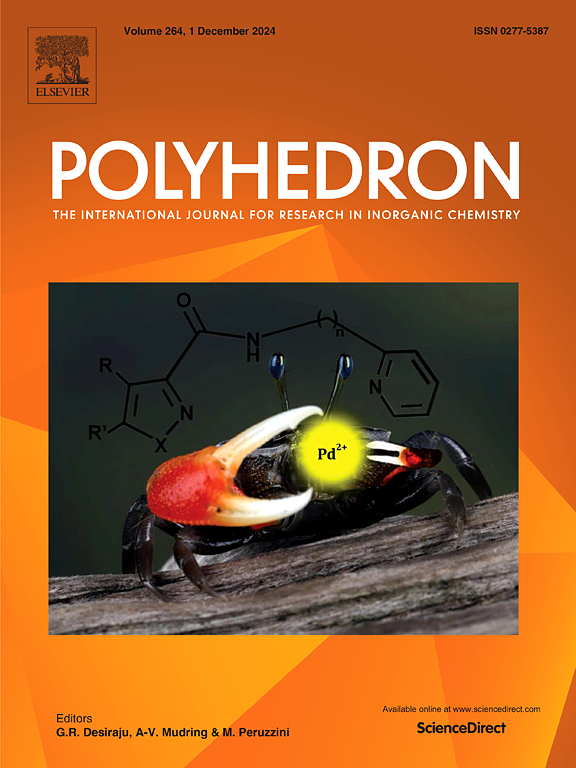Reactions of [Ru3(CO)10(µ-dppe)] towards tetramethylthiourea and N,N′-diisopropylthiourea: Generation of tri- and tetraruthenium carbonyl clusters bearing bridging/chelating dppe, triply/quadruply bridging sulfido and aminocarbene ligands
IF 2.4
3区 化学
Q2 CHEMISTRY, INORGANIC & NUCLEAR
引用次数: 0
Abstract
Two new sulfur-capped ruthenium clusters, a triruthenium [Ru3(CO)7(μ-dppe)(μ3-S)2] (1) (41% yield) and a tetraruthenium [Ru4(CO)6(µ-CO)2{η1-C(NMe2)2}(κ2-dppe)(µ4-S)2] (2) (15% yield) were obtained from the reaction of dppe-bridged triruthenium cluster [Ru3(CO)10(μ-dppe)] [dppe = 1,2-bis(diphenylhosphino)ethane] with four equivalents of tetramethylthiourea in THF at reflux. A similar reaction with N,N′-diisopropylthiourea in the same solvent and temperature exclusively afforded 1. Cluster 1 comprises an open Ru3S2 core capped by two μ3-sulfido ligands resulting from activation of the C–S bond of the thiourea ligand, and the dppe ligand bridges the open Ru….Ru edge occupying axial sites. Cluster 2 provides a unique example of a Ru4S2 skeleton with a square-planar arrangement of the four ruthenium atoms, two quadruply bridging sulfido ligands on opposite faces of the cluster, a terminally coordinated tetramethyldiaminocarbene ligand, formed by desulfurization of tetramethylthiourea ligand, a chelating dppe and two bridging carbonyl ligands on adjacent Ru–Ru vectors. The molecular structures of 1 and 2 have been determined by spectroscopic (IR, 1H NMR, and 31P{1H} NMR) data and single-crystal X-ray diffraction analysis. The bonding of these new compounds has been examined using DFT optimization and topological analysis using atoms in molecules (AIM) quantum theory.

求助全文
约1分钟内获得全文
求助全文
来源期刊

Polyhedron
化学-晶体学
CiteScore
4.90
自引率
7.70%
发文量
515
审稿时长
2 months
期刊介绍:
Polyhedron publishes original, fundamental, experimental and theoretical work of the highest quality in all the major areas of inorganic chemistry. This includes synthetic chemistry, coordination chemistry, organometallic chemistry, bioinorganic chemistry, and solid-state and materials chemistry.
Papers should be significant pieces of work, and all new compounds must be appropriately characterized. The inclusion of single-crystal X-ray structural data is strongly encouraged, but papers reporting only the X-ray structure determination of a single compound will usually not be considered. Papers on solid-state or materials chemistry will be expected to have a significant molecular chemistry component (such as the synthesis and characterization of the molecular precursors and/or a systematic study of the use of different precursors or reaction conditions) or demonstrate a cutting-edge application (for example inorganic materials for energy applications). Papers dealing only with stability constants are not considered.
 求助内容:
求助内容: 应助结果提醒方式:
应助结果提醒方式:


